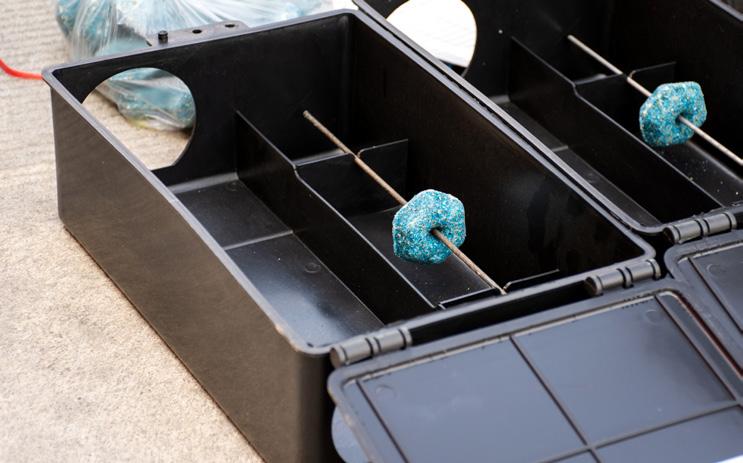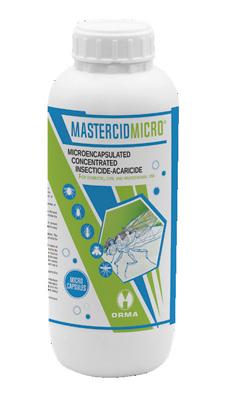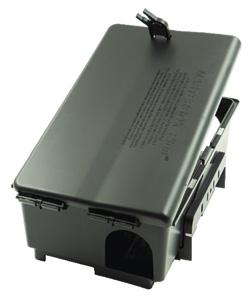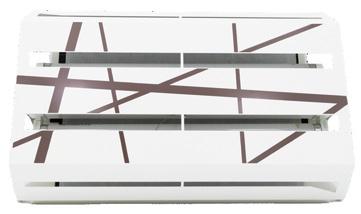
5 minute read
Alternative and complementary tools for rodent management
Sustainability also comes through the choice and use of innovative techniques, products and systems, often to be seen as complementary to the more conventional use of rodenticide baits with anticoagulant action
Francesco Florente Pest Management consultant
The European Commission itself, citing, for example, one of the considerations (No. 10) of Implementing Regulation (EU) 2019/637 (concerning the placing on the market of the active substance cholecalciferol), states that "rodents can carry pathogens responsible for many zoonoses, which can pose serious hazards to human or animal health. Anticoagulants, which are the main active ingredients used in rodenticides for now, also meet the exclusion criteria set out in Article 5(1) of Regulation (EU) No. 528/2012, as they are classified as toxic to reproduction category 1B and are mostly persistent, bioaccumulative and toxic (PBT) or very persistent and very bioaccumulative (vPvB) substances."
The same consideration goes on to state that "other alternative active ingredients currently approved for product type 14 and not subject to exclusion, namely carbon dioxide, alpha chloralose, aluminum phosphide, hydrogen cyanide, and corn cob powder, have inherent constraints and limited conditions of use. Non-chemical rodent prevention or control methods, such as mechanical, electric or glue traps, may not be sufficiently effective and raise further questions regarding their ethical acceptability and unnecessary suffering caused to rodents." The situation with regard to the proper use of rodenticide products (and others) is therefore complex and subject to change (a review of the approvals of AVK active substances, among the most widely used in chemical rodent control, is expected soon).
Rodent Management and sustainable development

It should also be considered that, as also reiterated by the European Commission, rodent management activities are certainly also useful for Sustainable Development. Managing populations of synanthropic rodents such as rats and mice can help to achieve Goal No. 2 ("Zero Hunger": limitation of food losses also due to rodent action) and Goal No. 3 ("Health and Welfare": limitation of health impacts) by assessing the health and commodity impacts that rodents can have in the area of Food Security and Public Health. Goal No. 15 ("Life on Earth"), also involves such activities, both in terms of protection of non-target fauna during "rodent control" activities but also for the very protection of biodiversity, sometimes threatened by rodent (rat) populations themselves, as predators of animals with protected status. Although these products are widely used, alternatives are already available on the market.
Use of biocides
However, the use of AVK products also deserves consideration, in order to verify how truly the conditions of use stated in biocide authorizations and thus in ministerial product labels are being applied. From this point of view, it is important to remember how the recent Decree 179/2021 "Sanctioning discipline for the violation of the provisions of Regulation (EU) No. 528/2012 concerning the making available on the market and use of biocidal products (21G00183) (OJ General Series No. 284 of 29-11-2021), which entered into force on 14/12/2021, clearly deals with these aspects. In fact, in Article 03 ("Violations regarding the making available on the market and use of biocidal products referred to in Article 17(1) of the Regulation"), the decree reads verbatim as follows:
"1. Whoever places a biocidal product on the market that is not authorized under the Regulation or under an authorization that is no longer valid or revoked, or in violation of the requirements of the authorization, shall be punished by arrest for up to three months and a fine from EUR 1,000.00 to EUR 10,000.00.
2. A professional or industrial user who employs an unauthorized biocidal prod- uct or an authorized biocidal product in violation of the relevant conditions of use specified in the authorization shall be punished with the same punishment as in paragraph 1."
Therefore, with particular reference to subsection 2, it is important for professional users to plan and apply rodent management services with rodenticide products by complying precisely with the conditions stated on the label.
Among the various safe conditions of use, which naturally refer to the EU Commission Implementing Regulations, it should be noted that, for each category of user (domestic user, professional user, trained professional/rodenticide trainer), there are very specific conditions of use, which are precisely stated on the labels of the products themselves.
The permanent use of anticoagulant baits is in fact not allowed, except under special operating conditions within which only a professional Deratization Company can act within limits for defined (e.g., with re-evaluations and time controls indicated).
In fact, only in the case of infestations or special conditions that can demonstrate the need for it, trained Deratization Professionals will be able to establish, by documenting and re-evaluating it over time, the need to permanently maintain this type of bait. All of these operations, in addition to being recorded, must be preceded by the application of an integrated approach that also and primarily involves the use of preventive measures (cleaning, vegetation and waste management, exclusion measures, etc.) and the use of physical trapping methods.
With regard to anticoagulant products, it is worth mentioning that formulations with concentrations ≥ 30 ppm (e.g., 0.005%) are to be considered for the exclusive use of professional users and trained professional users (the latter category includes "professional rodent controllers," with due differences regarding the mode of use). Other important data (updated to the end of 2020), reports us about 300 commercial rodenticide formulations, mostly represented by AVK-based products (e.g., brodifacoum, bromadiolone, difenacoum, difethialone, and flocoumafen).
The relatively low cost of these products and their wide availability spread their use, although the impacts on non-target fauna need to be considered, both in the case of primary intoxication (direct consumption of the baits) and secondary intoxication (consumption of intoxicated rodents still alive and/or their carcasses).
Technological traps
The world of rodent traps is also proceeding unabated, including at the technological level. In particular, the spread of traps equipped with capture and movement sensors makes it possible to make the activity of rodent control more "sustainable" both in limiting unnecessary movements of operators, but also in reducing the quantities of bait used. The use of this type of trap makes it possible to:
• Increase the effectiveness and efficiency of treatments.
• Optimize the application of biocides and reduce their quantities.
• Better ensure the welfare of non-target animals.
• Reduce unnecessary displacement.
• Provide capture data automatically.
These are devices that through communications via internet, radio or mobile networks enable accurate feedback on rodent presence and captures. After all, as extensively discussed in the first part of this paper, we are increasingly witnessing restrictions on the permanent use of rodenticide baits for the consequent application of risk mitigation measures.
In some contexts (e.g., in the Food Industry) it is actually necessary to organize frequent inspections in the traps intended for rodent trapping (even by the staff of the firm itself).
Glue traps
Finally, it is necessary to mention the extensive debate in the United Kingdom about the future of glue traps. As of April 2022, in England, new legislation restricting the use of glue traps became law after receiving the green light from the Monarchy, along with several other animal health and welfare bills. In this case, this statutory provision will ensure that licenses for the use of glue traps will be issued only to professional exterminators "on an exceptional basis," to preserve public health or safety where there are no suitable alternatives. However, the details of the licensing scheme have yet to be decided, and there is a strong commitment from the British Pest Control industry to ensure "realistic" conditions of use. Other situations are emerging in Wales, Scotland, and Northern Ireland. This information coming from the UK, certainly anticipates directions and reasoning that will need to be pursued in Italy as well as in the EU. Possibly, in addition to limitations, there are opportunities to approach a new way of managing synanthropic and pest rodents. These are important changes for a fundamental sector such as Pest Management, which sometimes still relies on "old customs," also dictated by end-customers' demands that are not well aligned with regulatory and technological evolution. We are therefore witnessing a further push for an integrated approach to the issue that must also take into consideration aspects of economic sustainability of such activities. This is and will only be possible through the collaboration of all stakeholders, a strong awareness of Pest Management Clients and the development of training and skills of Professionals and Authorities in charge of control.













